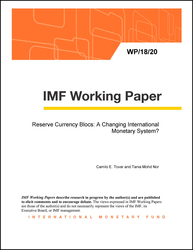
Reserve Currency Blocs: A Changing International Monetary System?
What is the extent of currency diversification in the international monetary system? How has
it evolved over time? In this paper, we quantify the degree of currency diversification using
regression methods of currency co-movements to determine the extent to which national
currencies across the world belong to a reserve currency bloc. We then use these estimates to
calculate the economic size of each currency bloc. A key contribution of our paper is that we
quantify the size of the Chinese renminbi bloc. Our analysis suggests that the international
monetary system has transitioned from a bi-polar system - consisting of the U.S. dollar and
the euro - to a tri-polar one that includes the renminbi. The dollar bloc is estimated to
continue to dominate, having the largest share in global GDP (40 percent), followed by the
renminbi (30 percent) and the euro blocs (20 percent). The geographical area of influence for
the RMB bloc appears to be most evident among the BRICS’ currencies. The British pound
and the Japanese yen blocs appear to play minor roles.
Publication date: January 2018
ISBN: 9781484338704
$18.00
Add to Cart by clicking price of the language and format you'd like to purchase
Available Languages and Formats
| English |
Prices in red indicate formats that are not yet available but are forthcoming.
Topics covered in this book
This title contains information about the following subjects.
Click on a subject if you would like to see other titles with the same subjects.
Currency Bloc , Internatinal Monetary System , International Monetary Arrangements and Institutions , Financial Aspects of Economic Integration , Open Economy Macroeconomics
Summary
Copyright © 2010 - 2024
Powered by:
AIDC



